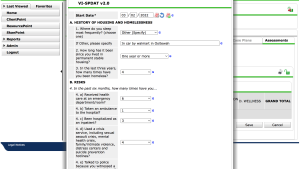Social workers understand that assessment is an ongoing component of the dynamic and interactive process of social work practice with, and on behalf of, diverse individuals, families, groups, organizations, and communities. Social workers understand theories of human behavior and the social environment, and critically evaluate and apply this knowledge in the assessment of diverse clients and constituencies, including individuals, families, groups, organizations, and communities. Social workers understand methods of assessment with diverse clients and constituencies to advance practice effectiveness. Social workers recognize the implications of the larger practice context in the assessment process and value the importance of inter-professional collaboration in this process. Social workers understand how their personal experiences and affective reactions may affect their assessment and decision-making.
Social workers:
- Collect and organize data, and apply critical thinking to interpret information from clients and constituencies.
- Apply knowledge of human behavior and the social environment, person-in-environment, and other multidisciplinary theoretical frameworks in the analysis of assessment data from clients and constituencies.
- Develop mutually agreed-on intervention goals and objectives based on the critical assessment of strengths, needs, and challenges within clients and constituencies.
- Select appropriate intervention strategies based on the assessment, research knowledge, and values and preferences of clients and constituencies.
- Demonstrate high quality, evidence-informed assessment skills to address and monitor complex systems related to client or community needs in different fields of practice.
Social workers should be aware that the service they provide should be supported by the most recent updated information of the client. Clients who are vulnerable may experience reoccurring events so it is important to adjust treatment plans and interventions accordingly. I can continue to engage with the competency by meeting the client where they are at. It is easy to get overwhelmed by unexpected events or setbacks but we must remind ourselves of our role in the client’s life. I will continue to present myself as a learner to collect the information needed to get to know my clients better and find the most appropriate resource for them.
Academic evidence:
1. Below is a case analysis I did on a pseudo client for a course called Social Work Practice with Individuals taught by Evie Baker. It details observations I made when discussing with my client. I differentiate the client’s presenting problem and underlying problem using direct quotes from the interview. I also was able to connect the client’s situation with the Social Learning theory and analyze my approach with this pseudo client.
2. Along with the Case Construction Analysis, I also completed a Biopsychosocial assessment on my pseudo client. In this assessment, I was able to guide the client through these questions to fully understand the problem. This assessment gave a clear outline on what information to ask in order to visually see a connection with the client’s past and present history. This assignment allowed me to become comfortable asking various questions to get to know my client on different levels and better understand their viewpoints. I see myself being challenged with not recognizing a connection between the client’s history and presenting problem. This may occur if the client does not share everything or if I did not properly record data. To improve this I have been practicing conversing more with the client and checking with them to see if I have recorded everything they would like me to know or if I comprehended their point of view correctly.
Biopsychosocial Assessment Form
Field Evidence:
3. The Chattanooga Regional Homeless Coalition uses the Homeless Management Information System (HMIS). For every client that goes through the system, a staff member will start by entering their basic information and creating a profile. As a helpline intern, I use this database daily. Once a client is entered, I am able to assess the client by completing a housing assessment also known as the Service Prioritization Decision Assistance Tool (SPDAT). This assessment asks questions to reveal the client’s physical, mental, and homelessness history. Once the housing assessment is completed I am then able to direct the client to the most appropriate resources based on their needs. Below you will see a picture of the first portion of the assessment.
(All information below is fictional and for illustration purposes only)

